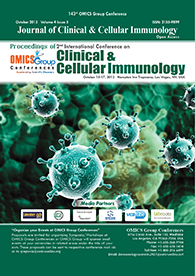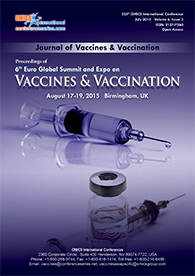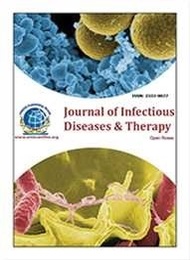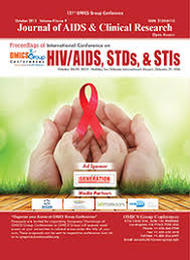Theme: HIV Vaccine Development: Immunological and Biological Challenges
Vaccine Immunology 2019
Conference Series LLC Ltd Conferences invites all the participants from all over the world to attend “Annual Congress on Vaccine Immunology & HIV/AIDS” during October 21-22, 2019 Copenhagen, Denmark, Europe which includes prompt keynote presentations, special sessions, workshops, symposiums, oral talks, poster presentations and exhibitions.
Immunology to enhance understanding of vaccine efficacy and use, and elaborates on the immune response to vaccination. The use of vaccines to prevent infectious diseases represents a tremendous accomplishment of biomedical science, especially considering the complex interplay of the immune system with innumerable pathogens. Vaccines have allowed for total eradication of one disease and have significantly reduced the incidence of other diseases. In order to have a successful vaccine-based eradication program, the infection must be limited to humans without an animal reservoir and only one or a few strains may exist in viral infection. These strains must have constant antigenic properties. A number of vaccine types exist, both traditional and innovative, and are described herein.
Who should attend?
- Microbiologists
- Bacteriologists
- Virologists
- Vaccine Immunologists
- Parasitologists
- Mycologists
- Pathologists
- Pharmacists
- Epidemiologists
- Health Care Professionals
- Infectious Diseases Specialists
- Infection Prevention and Infection Control Specialists
Why to attend?
With members from around the world focused on learning about global trends on Vaccine Immunology and its advances in therapeutic and diagnostic market, this is your best opportunity to reach the largest assemblage of participants from the Vaccine Immunology community. This particular conference conduct presentations, distributes information, conducts meetings with current and potential scientists, make a splash with new drug developments, and receive name recognition at this 2 days event. World renowned speakers, the most recent therapeutic and diagnostic techniques, developments, and the HIV Vaccine Development: Immunological and Biological Challenges are hallmarks of this conference.
Targeted Audience
- Directors, Board Members, Presidents, Vice Presidents, Deans and Head of the Departments
- Infectious Diseases Researchers, Scientists, Faculties, Students
- Infectious Diseases Associations and Societies
- Medical Colleges
- Pharmaceutical Companies and Industries
- Medical Devices Manufacturing Companies
- Drug Manufacturing Companies and Industries
- Laboratory Technicians and Diagnostic Companies
- Business Entrepreneurs and Industrialists
- Training Institutes
- Software Developing Companies
- Data Management Companies
Track 1: Vaccines and Vaccinology
Vaccine is a biological preparation that improves immunity to particular disease. It contains certain agent that not only resembles a disease causing microorganism but it also stimulates body’s immune system to recognise the foreign agents. Vaccinology describes vaccine development and how the immune system retorts to vaccines, but also includes ongoing evaluation of immunization programs, vaccine safety and effectiveness, as well as surveillance of the epidemiology of vaccine-preventable diseases.
Track 2: HIV/AIDS: Acquired Immune Deficiency Syndrome
HIV or Human Immunodeficiency Virus that damages the immune system. Untreated HIV contaminates and murders CD4 cells, which are a sort of immune cells called T cells. After some time, as HIV kills more CD4 cells, the body is bound to get different sorts of diseases and malignant growths. HIV is transmitted through organic liquids that incorporate blood, semen, vaginal and rectal liquids, and breast milk. The infection doesn't spread in air or water, or through easygoing contact. HIV is a lifelong condition and right now there is no fix.
Track 3: HIV Vaccines
The most important breakthroughs of the past century involved the development of vaccines to protect against viruses: smallpox, polio, hepatitis, human papillomavirus (HPV), and even chickenpox. But one virus remains elusive to those seeking to create a vaccine to guard against it: HIV. Getting vaccinated early, before sexual exposure, is also effective in preventing certain types of STIs. Vaccines are available to prevent human papillomavirus (HPV), hepatitis A and hepatitis B.
Track 4: Clinical Immunology: Current & Future Research
Immunology is the study of the immune system. The immune system is how all animals, including humans, protect themselves against diseases. The study of diseases caused by disorders of the immune system is clinical immunology.
Track 5: Vaccines for Immune Mediated Diseases
Patients with immune-mediated inflammatory diseases (IMID) such as RA, IBD or psoriasis, are at increased risk of infection, partially because of the disease itself, but mostly because of treatment with immune-modulatory or immunosuppressive drugs. In spite of their elevated risk for vaccine-preventable disease, vaccination coverage in IMID patients is surprisingly low. Although the reduced quality of the immune response in patients under immunotherapy may have a negative impact on vaccination efficacy in this population, adequate humoral response to vaccination in IMID patients has been demonstrated for Hepatitis B, Influenza and Pneumococcal vaccination
Track 6: Pediatric Vaccination and Child Immunization
Antibodies that should be regulated to people amid the youth phase of life can be named as Child immunizations. These immunizations are basically in charge of the enlistment of a safe framework and advancement of immunogenic reaction inside the tyke. The sicknesses avoided by the new born child and youth antibodies are not kidding and even fatal. Measles can spread to the cerebrum, cause mental harm and demise. Mumps can cause lasting deafness. Polio can cause loss of motion. Unfortunately, these illnesses have not vanished. There is no treatment and no solution for maladies like measles, polio, and tetanus. The best way to ensure your youngster is through immunization.
Track 7: Human Vaccines-Infectious and Non- Infectious
Infectious diseases, including HIV/AIDS, tuberculosis(TB), malaria, poliomyelitis, and some others tropical diseases (NTDs) are rapidly spread out through communication(verbal), water, and wind. It also transmitted by vectors (mosquitoes, flies) and a major issue in developing countries. In the past, infectious diseases had been widely spread-out in developing countries and chronic diseases were found primarily in high-income countries. However, the global pattern of disease burden is shifting. While infectious disease still remains a major problem in many countries, chronic diseases, including such non-communicable conditions as cardiovascular disease, cancer, diabetes, and respiratory disease, are now the major cause of death and disability, not only in developed countries but also worldwide. The greatest total numbers of chronic diseases (Alzheimer, Arthritis, Asthma, Cancer, COPD, Crohn disease, Cystic fibrosis, Diabetes) deaths and illnesses now occur in up-growing countries.
Track 8: Viral Immunology
Viruses are firmly immunogenic and actuate two sorts of resistant reactions; humoral and cellular. The collection of specificities of T and B cells are framed by modifications and substantial transformations. T and B cells don't, for the most part, perceive similar epitopes present on a similar infection. B cells see the free unaltered proteins in their local 3-D adaptation though T cells typically observe the Ag in a denatured frame related to MHC atoms. The qualities of the resistant response to a similar infection may vary in various people contingent upon their hereditary constitutions.
Track 9: Cancer and Tumor Immunobiology
Cancer immunology is an area of immunology that studies relations between the immune system and cancer cells. It is a field of research that objects to discover cancer immunotherapies to treat and retard progression of the disease. The immune system is the body’s first line of defense against most diseases and infectious invaders. Tumor Immunobiology the immune system can promote the elimination of tumours, but often immune responses are modulated or suppressed by the tumour microenvironment. The Tumour microenvironment is an important aspect of cancer biology that contributes to tumour initiation, tumour progression and responses to therapy.
Track 10: Pathology and Immunology
Immunopathology is a branch of medicine that deals with immune responses associated with the disease. It incorporates the investigation of the pathology of a life form, organ framework, or ailment concerning the insusceptible framework, invulnerability, and resistant reactions. In science, it alludes to the harm caused to a creature by its own resistant reaction, because of contamination. Two decades of clinical involvement with immunomodulatory medicines for various sclerosis points to unmistakable immunological pathways that drive ailment backslides and movement. Immunopathology could allude to how the outside antigens cause the invulnerable framework to have a reaction or issues that can emerge from a living being's own particular resistant reaction on itself. There are sure issues or blames in the invulnerable framework that can prompt more genuine sickness or malady.
Track 11: Immunology and Dermatology
This field specializes in the treatment of immune-mediated skin diseases such as alopecia, lupus, bullous pemphigoid, pemphigus vulgaris, and other immune-mediated skin disorders. Immunodermatology testing is essential for the correct diagnosis and treatment of many diseases affecting epithelial organs including skin, mucous membranes, gastrointestinal and respiratory tracts. The various diseases often overlap in clinical and histological presentation and, although the diseases themselves are not common, may present with features of common skin disorders such as urticaria, eczema and chronic itch. Therefore, the diagnosis of an immunodermatological disease is often delayed.
It includes studies skin as an organ of immunity in health and disease. Several areas have special attention, such as photo-immunology (effects of UV light on skin defense), inflammatory diseases such as Hidradenitis suppurativa, allergic contact dermatitis, and atopic eczema, presumably autoimmune skin diseases such as vitiligo and psoriasis, and finally the immunology of microbial skin diseases such as retrovirus infections and leprosy. New therapies in development for the immunomodulation of common immunological skin diseases include biologicals aimed at neutralizing TNF-alfa and chemokine receptor inhibitors.
Track 12: Travel Vaccines
Travel vaccines, additionally called travel inoculations, are shots voyagers can get before visiting certain territories of the world that assistance shields them from genuine diseases. Immunizations work by presenting the body to germs or parts of germs of the sickness it will ensure against. Anyone can't get the ailment from the antibody in light of the fact that the infections or microorganisms are dead or seriously debilitated. The body reacts to the inoculation by making antibodies that will ensure us in the event that we are presented to the illness later on.
Track 13: Epidemiology of STD-AIDS and Infectious Diseases
Infectious Diseases keep on substantially affecting the strength of health communities around the world. From the worldwide HIV and tuberculosis (TB) epidemics, to the danger of safe microscopic organisms, to the test of developing and recently distinguished pathogens. All propel the requirement for new strategies to distinguish such pathogens, to comprehend their pathogenesis, and to devise powerful mediations for their anticipation and control. Investigations of the study of disease transmission of infectious diseases incorporate assessment of the components prompting contamination by a life form, factors influencing the transmission of a living being, and those related with clinically unrecognizable disease among the individuals who are affected.
Track 14: STD: Sexually Transmitted Disease
The term Sexually Transmitted Disease (STD) is utilized to allude to a condition go starting with one individual then onto the next through sexual contact. You can get a STD by having unprotected vaginal, anal or oral sex with somebody who has the STD. A STD may likewise be known as a Sexually Transmitted Infection (STI) or venereal ailment. A few STDs can spread utilizing unsterilized medication needles, from mother to newborn child amid labor or breast feeding and blood transfusions. The World Health Organization (WHO) gauges that there are in excess of 1 million new STDs gained every day all around. Individuals between the ages of 15- and 24-years secure portion of every single new Std, and 1 out of 4 explicitly dynamic pre-adult females has a STD. Be that as it may, STD rates among seniors are expanding.
Track 15: Viral, Bacterial, Parasitic STDs
Individuals when all is said in done will in general lump sexually transmitted diseases together under one class; as illness which influence the sexual organs. Be that as it may, beside the way that STIs can exhibit manifestations somewhere else on the body, the kind of living being causing these contaminations can fluctuate as well. At times, they are caused by a bacterium, in others a viral strain, in somewhere in the range of a growth, and in different cases a parasite. Furthermore, as you may expect, the treatment for STIs can fluctuate as indicated by their motivation, similarly as they can for non-sexual illness. Diverse sorts of disease react to various kinds of treatment; and keeping in mind that some can be relieved; others can't, and should be overseen.
Track 16: Infectious Diseases
The diseases caused by germs and which may infect any part of the body are called infectious diseases. They can be spread by any means where there is a germ. They are caused by pathogenic microorganisms such as bacteria, virus, parasites and fungi. Germs can be spread by direct or indirect contact. Vaccination, maintenance of proper hygiene and medicines help in the prevention of infection.
Track 17: Vaccines and Vaccination
Vaccines are the products that are able to produce immunity from a disease and can be administered through needle injections, by mouth and by aerosol. Vaccination is the injection of a killed or weakened organism that produces immunity in the body against that organism.
Track 18: Immunology of Infections
Immunology of infections means the battle between pathogens and the host immune defences. Immunology is the branch of science concerned with the various aspects related to immune system, innate and acquired immunity. Immunology also deals with laboratory techniques involving the interaction of antigens with specific antibodies.
Track 19: Allergy, Asthma, Autism, and Immunology
Allergies, also known as allergic diseases, are a number of conditions caused by the immune system to something in the environment that usually causes little problem in most people. A damaging immune response by the body to a substance, especially a particular food, pollen, fur, or dust, to which it has become hypersensitive. Common allergens include pollen and food. Symptoms of food allergy include abdominal pain, bloating, vomiting and swelling of the skin during hives. Effective management of allergic diseases relies on the ability to make an accurate diagnosis.
Track 20: OncoImmunology
Although tumor immunologists have been convincing themselves over the last decades that cancer can be conceived as an immunological problem—a few cells expressing novel antigens proliferate in the uncontrolled fashion, in spite of the immune system’s attempts to eliminate them—they have been standing alone. Most basic cancer researchers, drug developers and clinical oncologists have been considering neoplasia as a purely cell-autonomous genetic disease and have been ignoring or even neglecting the impact of immunology on tumorigenesis, for multiple reasons.
Track 21: Next-Generation Vaccine Delivery Technologies
Drug delivery systems are engineered technologies for the targeted delivery and/or controlled release of therapeutic agents. Drugs have long been used to improve health and extend lives. The practice of drug delivery has changed dramatically in the last few decades and even greater changes are anticipated in the near future. Biomedical engineers have not only contributed substantially to our understanding of the physiological barriers to efficient drug delivery—such as transport in the circulatory system and drug movement through cells and tissues—they have contributed to the development of a number of new modes of drug delivery that have entered clinical practice. Role of vaccine delivery technologies includes rational development of vaccines, achieving immunization goals, supporting best clinical practice.
Track 22: HIV/AIDS Vaccines
An AIDS vaccine does not yet exist, but efforts to develop a vaccine against HIV, the virus that causes AIDS, have been underway for many years. An HIV vaccine could be effective in either of two ways. A “preventive” vaccine would stop HIV infection occurring altogether, whereas a “therapeutic” vaccine would not stop infection, but would prevent or delay illness in people who do become infected, and might also reduce the risk of them transmitting the virus to other people. Although a preventive vaccine would be ideal, therapeutic vaccines would also be highly beneficial. The basic idea behind all HIV vaccines is to encourage the human immune system to fight HIV.
Track 23: Vaccines for Vector-borne Diseases
Vaccines that target blood-feeding disease vectors, such as mosquitoes and ticks, have the potential to protect against the many diseases caused by vector-borne pathogens. Vector-borne diseases are among the most complex of all infectious diseases to prevent and control. Vector- borne diseases, most of which are transmitted in and around the home, are best controlled by a combination of vector control (use of public health insecticides on bednets, or by spraying), medicines and vaccines.
Historically, successful vector-borne disease prevention resulted from management or elimination of vector populations. Malaria was driven out of the USA and most of Europe in this way. Where vector control has been consistently applied in the past, the results have been dramatic, especially with early efforts to control malaria by spraying the inside surfaces of houses with insecticides. Indoor Residual Spraying (IRS) and long-lasting insecticide treated bednets have been very effective over the last 10 years and are widely regarded as one of the main contributors to the more than 1 million lives saved.
Conference Highlights
- Vaccines and Vaccinology
- HIV/AIDS: Acquired Immune Deficiency Syndrome
- HIV Vaccines
- Clinical Immunology: Current & Future Research
- Vaccines for Immune Mediated Diseases
- Pediatric Vaccination and Child Immunization
- Human Vaccines-Infectious and Non- Infectious
- Viral Immunology
- Cancer and Tumor Immunobiology
- Pathology and Immunology
- Immunology and Dermatology
- Travel Vaccines
- Epidemiology of STD-AIDS and Infectious Diseases
- STD: Sexually Transmitted Disease
- Viral, Bacterial, Parasitic STDs
- Infectious Diseases
- Vaccines and Vaccination
- Immunology of Infections
- Allergy, Asthma, Autism, and Immunology
- OncoImmunology
- Next-Generation Vaccine Delivery Technologies
- HIV/AIDS Vaccines
- Vaccines for Vector-borne Diseases
To share your views and research, please click here to register for the Conference.
To Collaborate Scientific Professionals around the World
| Conference Date | October 21-22,2019 | ||
| Sponsors & Exhibitors |
|
||
| Speaker Opportunity Closed | |||
| Poster Opportunity Closed | Click Here to View | ||
Useful Links
Special Issues
All accepted abstracts will be published in respective Our International Journals.
- Journal of Infectious Diseases and Therapy
- Journal of Clinical & Cellular Immunology
- Journal of Vaccines & Vaccination
Abstracts will be provided with Digital Object Identifier by




